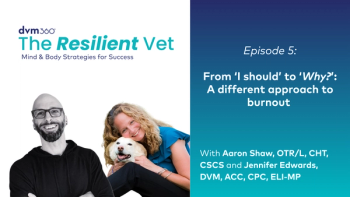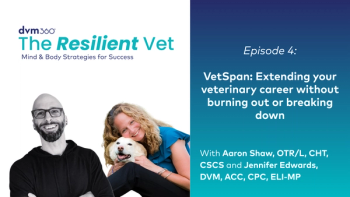
Veterinarians and nonprofits: The war is over
Rescue isn't a panacea for every pet, nor will cultivating rescue work be the be-all end-all solution for all private practices trying to compete in a crowded market. But it can work, and save lives and alleviate suffering along the way.
Rescue isn't a panacea for every pet, nor will cultivating rescue work be the be-all end-all solution for all private practices trying to compete in a crowded market. But it can work, and save lives and alleviate suffering along the way.
While private practices and nonprofit shelters providing veterinary medical services elsewhere (like Alabama and Texas) are at each others' throats for getting in each others' pockets, one clinic has figured out a way to make the shared mission to improve pet welfare work for everybody-business and nonprofit.
Animal Care Clinic is a growing private practice in Huntington, West Virginia. The clinic-built 50 or so years ago-serves a clientele of modest means. The current owner, Dr. Mark Ayers, bought it in 1995. Dr. Ayers also owns and manages nearby Ayers Animal Clinic and was the only veterinarian at both clinics for a number of years.
Chad Ferrell has been practice manager at Animal Care Clinic since 2003. In 2009, six years after becoming manager and a year into the recession, Ferrell went to Dr. Ayers with a plan to grow the clinic. He wanted to actively pursue rescue organizations as clients. Dr. Ayers was doubtful, but Ferrell had a proven track record managing the clinic, numbers that made sense and a passion for the work. Dr. Ayers said he was willing to try it if the clinic's full-time associate veterinarian, Dr. Ginger Ellis, was on board. Being a dedicated rescue advocate herself, she was.
First-year success
Ferrell's plan limited the practice's exposure to risk. He offered a set discount to one rescue group and evaluated weekly revenue, and examined the year-end tax return to decide to continue or not.
“The tax return revenue was up,” Ferrell says. “Not much, but it was up. So we kept doing it.”
Would the clinic have been up without this move, just from the recovery that followed the recession?
“Maybe. But we were growing, and other clinics weren't,” Ferrell says. “The [drug] reps would talk about how hard it was to get time here because we always had appointments; the delivery guy would say how our orders were bigger. Now we're looking for another doctor, when some [other local clinics] are closing a half-day a week.”
Time to socialize
One demonstrable difference? The clinic's Facebook page. Animal Care Clinic has nearly 1,100 followers; Ayers Animal Clinic, right up the road, under the same ownership and management philosophy but without the rescue work, has barely 600 followers. “Every time I get a notice that we have a new follower, I click on who it is,” Ferrell says. “Almost all their mutual friends are associated with rescue.”
Delegate away!
For a good working relationship with a shelter or rescue to financially and logistically work in practice, Ferrell says time management and delegation are a must: “None of this will work in one of those clinics where the doctor has to do everything. It can't be the doctor doing all the client education. But a technician can spend an hour talking to a rescue while the doctor and another technician see four more rooms. It's all about how you can get the work done, and how each person can be making the most money for the clinic with their time.”
Ferrell encourages his team members as well as rescue volunteers and fosters to share on social media. “The staff is on Facebook almost all the time, posting pics of their own pets, so they get that,” he says. “We want others, 15 minutes after they walk out of here, posting to all their friends about how glad they are that Animal Care Clinic got them in right away even though [the client] is just a foster and how much they appreciate us getting Fluffy on meds today instead of her having to wait until tomorrow to start feeling better.”
Building long-term credibility
The longer the practice continues with rescues, the more the clinic benefits, Ferrell says. But it wasn't easy to build support from the rescue community. He put in the hours: “There was about six months when every Saturday, it was a choice between go do something I wanted to do, or do something I knew I needed to do to make this work.”
Ferrell spent most of that time at adoption events in nearby malls and neighboring towns. The rescues were thrilled to have a clinic representative there. Ferrell lent credibility, and potential adopters were more willing to stop and check out the animals. He would answer general questions from potential adopters, give talks on specific topics like adopting older dogs from the shelter, or vaccination and preventive care schedules. He gave away a few promotional items the clinic got for free: dog toys, flea and tick preventives, and puppy and kitten care books, courtesy of a pet food company. And he tucked an Animal Care Clinic business card inside each book or brochure.
Growing the business
Ferrell's plan paid off. While the first rescue he worked with was a small group that didn't last, the plan did. By the end of 2010, when the original rescue had broken up, two more came to the clinic to ask to become clients.
Today, the clinic works with more than 30 organizations, many across state lines, ranging from single individuals to groups with their own full-time veterinarians on staff. The plan worked so well that business outgrew Dr. Ayers' ability to keep up with both practices, and Ferrell bought Animal Care Clinic in 2013.
Ferrell estimates that 20 percent of the animals the clinic cares for are rescues, with between 10 and 20 coming through the clinic for the first time each week. “And that's just the new ones,” Ferrell says. “That doesn't count booster visits, if they get sick, and when they come in for their surgeries.”
Rescue pricing
To make sure Animal Care Clinic doesn't lose money, practice owner Chad Ferrell calculated the cost and necessary profit margin for a bundle of services he saw as most useful to rescued animals: physical exam, distemper parvo vaccine combo, rabies vaccine, spay or neuter, fecal test and heartworm test. He gives a 25 percent discount, and the clinic still makes money. If organizations ask to buy individual services, the clinic can't offer the same discount because of the increased time to handle those transactions individually.
At a time when other practitioners complain that nonprofits have stolen all their spay and neuter business, Animal Care Clinic has a weeks-long surgery backlog at prices that guarantee reasonable profit.
The rescue work also is not limited to spays, neuters and vaccinations-the bread and butter that many veterinarians resent the loss of so keenly. Each of these rescues has its own protocols, depending on mission and resources. Most cover FeLV/FIV/heartworm screening for cats. Many also have standing authorization for fecal exams and parvo tests for dogs with diarrhea or skin scrapes for animals with itching and hair loss.
No “us vs. them”
Clinic employees are all just as passionate about pet health as Ferrell, so rescuers get a consistent message of what services are needed and why that care is worth paying for. There is no temptation at Animal Care Clinic to see it as “good-hearted rescuers” vs. “money-grubbing veterinary clinic” because, as Ferrell puts it to any employee who complains, rescuers also pay the bills. Early on, one key technician exclaimed, “Omigod, these rescue people think we're at their beck and call!” Ferrell responded on the spot: “Omigod, these rescue people are paying your check!”
Not all rescues are created equal
When money gets tight, you want to work with organizations that halt intake or put additional effort toward fundraising rather than trying to cut costs by asking to pay less for care or by shortcuts in exams, testing and more. An organization that brings a lot of animals through the clinic, Pitiful Paws Rescue, occasionally goes on intake hold when their bill gets too high. “We totally suck at intake hold,” laughs Pitiful Paws Rescue co-founder Desiree Huff, “so it's a good thing people respond when we make an appeal!”
Sometimes coordinating care for rescues bringing in so many animals at once can be complicated. Some rescues don't always have advance notice about incoming animals or what condition they'll be in. Frequently, these are animals that need to be examined, and possibly treated, immediately. There's nothing quite like having two litters of parvo pups, a hit-by-car dog and a trap full of feral cat neuters come in over the space of an hour … on top of a full surgery and appointment schedule. Oh, and 10 health certificates to be written for dogs leaving tomorrow at 5 am.
The two-hour lunch
One technique Ferrell uses to provide some buffer is holding onto a long-held tradition at the clinic: the two-hour lunch. Originally instituted to give Dr. Ayers more flexibility when he was the only veterinarian at both clinics, the lengthy lunchtime has proven very useful the more rescue work the clinic does.
On not-so-crazy days, everyone gets a much-needed break. On crazy days, the clinic buys lunch.
Ferrell also cultivates a lot of patience for what other clinics would call drama. He realizes staff members are asked to be extra-flexible at work and juggle a lot of rapidly changing tasks. And that takes a toll. It can leave everyone short on patience or unable to summon the skill to negotiate day-to-day conflicts calmly. But it is that same emotional investment that makes the whole thing spin.
Working with rescues: Takeaway tips
1. Run the numbers. Pricing as well as revenue and new-client goals should work for your practice in your market with your profit margin.
2. Find and continue to inspire team members who share your passion. It's just not possible any other way.
3. Educate rescue administrators, volunteers, fosters, donors and adopters. You benefit them (smarter pet advocates), you benefit your practice (grateful and educated clients) and you benefit the pets. Show and tell them!
When I interviewed technician Steph Dunkle about the craziness of serving so many masters in practice, everything came to a halt in the middle of a hurricane of paperwork and treatments. Not lifting her eyes from the forms in her hands, Dunkle told me, “It's worth it when they get homes.” Heads nodded around the room, then the whirl of activity started back up.
Rescue isn't a panacea for every pet, nor will cultivating rescue work be the be-all and end-all solution for every private practice trying to compete in a crowded market. But it can work, and save lives and alleviate suffering along the way.
Dr. Myers is an associate working in Austin, Texas. She runs the website justvetdata.com.
Newsletter
From exam room tips to practice management insights, get trusted veterinary news delivered straight to your inbox—subscribe to dvm360.




